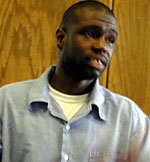By Art Hughes
Minnesota Public Radio
September 25, 2002
On Sept. 25, 1992, 30-year police veteran Jerry Haaf died on the floor of the Pizza Shack restaurant in south Minneapolis after being shot in the back while on his morning coffee break. The execution-style shooting remains one of the most shocking acts of violence against an officer in Minneapolis history. Haaf's killing came during a low point in police-minority relations at home and nationally: In Los Angeles, riots followed the acquittal of police officers in the Rodney King beating trial. In Minneapolis gangs traded gunfire daily, rumors of Minneapolis police misconduct were rampant, and the police administration was at a loss for how to gain the trust of the city's minority residents. MPR News looks back at the legacy officer Jerry Haaf's death left on the city and the progress and challenges since then.
| |
|
|
|
||
Barely two minutes into Minneapolis Police sergeant John Pielow's patrol on East Lake Street, he's flagged down by a cabbie to get an intoxicated passenger out of the backseat.
While he's out on the sidewalk, a police radio bulletin warns of a man with a shotgun seen getting into a dark colored Lincoln near the Pizza Shack. Pielow takes a long look in the direction of the restaurant about four blocks away. While Pielow attends to the call, the Lincoln vanishes into the night.
"There's nobody been in this occupation that hasn't been hurt." Pielow says. "One of the first things you learn when you become a cop is you will get hurt and you will likely be hurt numerous times in your career."
Minneapolis police refer to this area as a gang war zone where competing cartels carry out periodic battles over turf. North of Lake is populated by the Hispanic gangs such as the Sereno 13s and Vatos Locos. South of Lake there are more African American gangs like the Rolling 30's Bloods, the Gangster Disciples and the Vice Lords. It was the Vice Lords that figured prominently in the killing of Officer Jerry Haaf Sept. 25, 1992.
"I remember that night very well," said police Lt. Mike Sauro, who was a Third Precinct shift commander at the time of Haaf's murder.
| |
|
|
|
||
"We were headed to the Pizza Shack to eat, which was approximately a mile away," Sauro said. "As we crossed the tracks approaching Hiawatha a garbled call came out on the radio.(We) ascertained it was 'officer needs help. Officer down at the Pizza Shack.'"
Sauro and his partner were the first officers on the scene.
"And I distinctly remember officer Haaf lying on the ground chest down," Sauro said. "And I saw where the injuries were on him, where the bullet wounds were, where the blood was coming from and I felt it was definitely fatal wounds by their locations."
The Haaf shooting is widely believed to be retaliation for an incident earlier in the evening.
Transit police were removing a passenger in north Minneapolis who didn't have bus fare. The man was black and also blind. An altercation erupted and a crowd formed. In a brief, tense exchange one of the transit cops got punched.
Later that night Police Chief John Laux and other city officials were meeting with neighborhood residents at North High School to talk about police relations.
"We were in the middle of this meeting and a group burst in and wanted to know what we were going to do about this blind, black bus rider that was thrown off the bus for not paying his fare; just another example of police brutality and police insensitivity," Laux remembered.
Someone at the North High School meeting broke out the windshield of a squad car in the parking lot. Hours later, Haaf would be shot dead.
"Certainly we could say something was going to happen," Laux said. "But cold blooded murder of a police officer? That just isn't what happens in Minneapolis."
In the summer of 1992, the lines between community activist and gang-banger were blurred. Gang leaders held sway over an impoverished minority population that police departments, politicians and social service organizations had trouble reaching.
A group of known gang members formed a group called, United For Peace and worked with police, reaching out to young, black residents to stop gang shootings. But many officers reviled United For Peace and openly opposed police administrators who met with the group.
The Haaf shooting not only shocked the city, it also opened a giant chasm in the department. "It is a tightrope," Laux said. "A balancing act to keep the officers engaged and motivated and feel like they're supported by the chief and also keep officers in some cases who always walk that fine line edge who look for any excuse to be judge and jury out on the street."
It was a tense seven weeks before police brought charges in the shooting. In that time the Minneapolis Police Federation aired a radio ad looking for tips.
"They stalked him, waited until he was alone, snuck up behind him, fired their illegal guns into his back...," the ad's narrator is heard saying. It urged citizens to call the union, not the administration. It went on:
"People are afraid in Minneapolis. If the police aren't safe, who is? Your police, members of the Minneapolis Police Federation are asking for your help. With your help we'll catch the killers. But the violence must stop or jobs will continue to leave, your neighbors will keep moving...."
| |
|
|
|
||
Police eventually arrested four black men, all connected to the Vice Lords gang. Mwati "Pepi" McKenzie was convicted as one of two gunmen. He maintains he wasn't given a fair trial and unsuccessfully took his complaints to the Minnesota Supreme Court. He continues to work on his own behalf from the state prison in Oak Park Heights where he's serving a life sentence. He recently filed a new challenge to have his conviction overturned.
"You get jurors, 12 people from Minnetonka, come on now," McKenzie said. "They live in their own secluded world. You know, going to work, making money, coming home and focusing in on what's on Channel 11, 5, 4 and what's on the news. They watch things like the Robb Report all day. So basically what's going on in the inner city has no bearing on them, they don't even care. But they bring these 12 people on trial they sit there and they look at what's going on, they really don't know who's lying or who's telling the truth."
Haaf's death awakened the entire state to the extreme threat of gangs. Lt. Sauro, a controversial cop who has clashed with the administration, theorizes the killers may have acted out of some sort of delusional attempt to gain power, but instead generated a backlash.
"I think a lot of the politicians realized that these gangs have to be destroyed, end of discussion," Sauro said. "Destroy their leadership and get rid of them."
Gang violence helped push Minneapolis' homicide rate to its highest peak ever in 1995. Violent crimes have decreased since then, though and police say the creation of the Minnesota Gang Strike Force and increased sentences for crimes associated with gang activity are a big reason. But department officials and officers alike say gangs are still active, but are a much lesser threat than they were ten years ago, partly because so many gang bangers are in jail. But any bridge between the police and the city's poor, black residents is fragile.
Former Chief Laux says 10 years later, the same undercurrent of tension remains.
"When there isn't some sort of pressure you get lulled into kind of 'well, it's kind of calmed down and what's the big deal?' and you kind of go on business as usual," Laux said. "And maybe ten years from now we'll dig out the headlines and say we haven't accomplished anything. I hope not."
More from MPR


